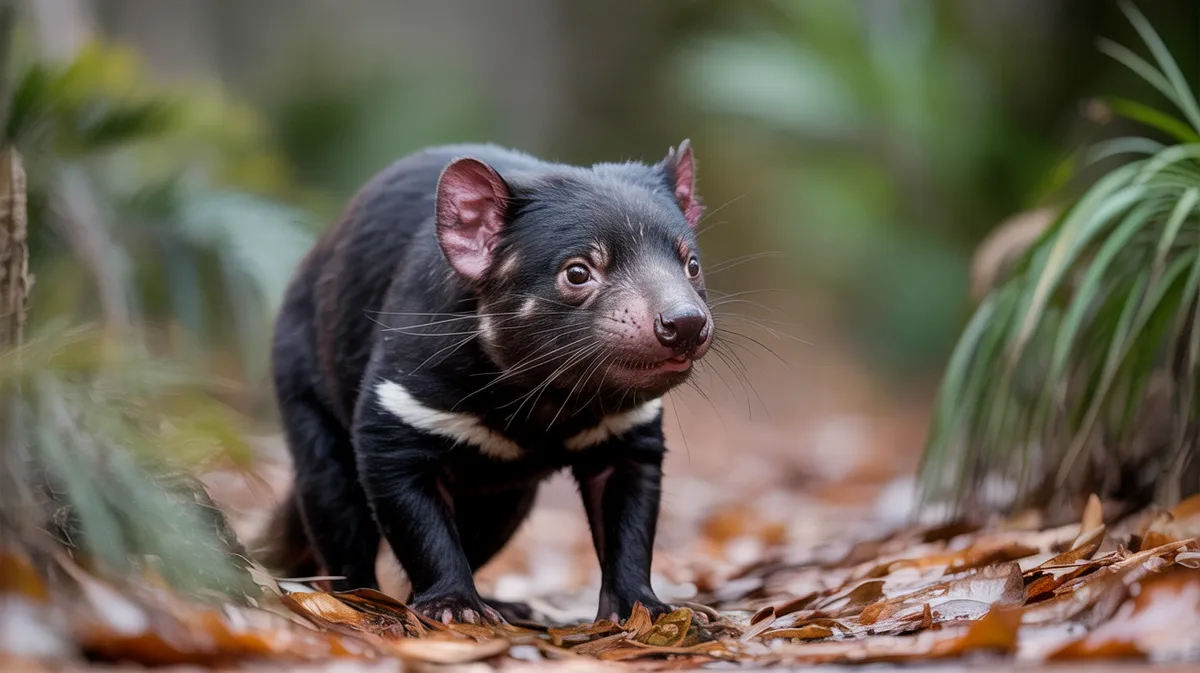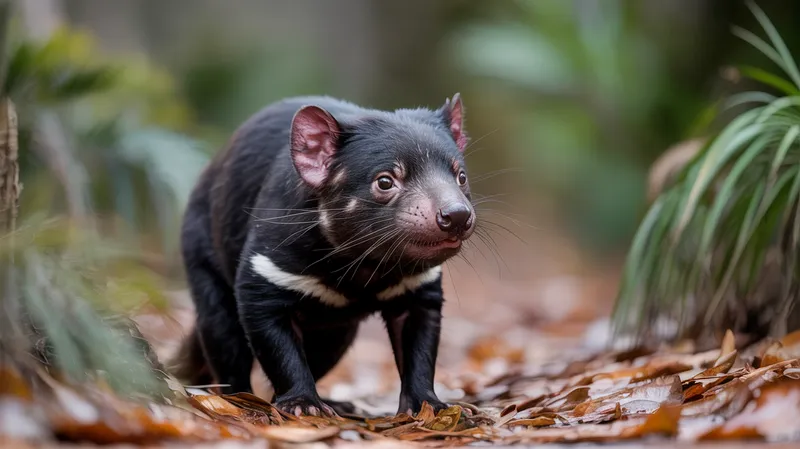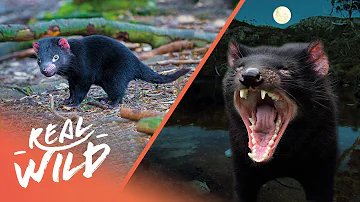
Tasmanian Devil
Sarcophilus harrisii

Meet the Tasmanian Devil
The Tasmanian Devil is the largest carnivorous marsupial in the world and is native exclusively to the island of Tasmania, Australia. It is known for its stocky build, black fur, and its powerful, bone-crushing jaws. Tasmanian Devils are nocturnal and solitary, often scavenging for carrion but also hunting small animals. Their reputation for loud screeches, fierce temperament, and voracious appetite has made them iconic, though they face serious threats from a contagious facial tumor disease.
Classification
Mammal
Habitat
Temperate forests and woodlands
Diet
Carnivore
Lifespan
5-7 years
Conservation
Endangered
Weight
6-14 kg
📖Fascinating Facts
Powerful Jaws
Tasmanian Devils have extremely strong jaws capable of generating a force powerful enough to crush bones, which helps them consume nearly all parts of their prey.
Nocturnal Scavenger
They are primarily nocturnal and spend most of their nights searching for food, often scavenging for dead animals but also occasionally hunting live prey.
Unique Name Origin
Their fierce vocalizations and aggressive feeding behavior led early European settlers to nickname them 'devils.'
📋Detailed Description
The Tasmanian devil (Sarcophilus harrisii) is a robust, medium-sized marsupial with a head-body length of 52–80 cm and a tail measuring 23–30 cm; adults typically weigh between 6 and 8 kg, with males larger than females. Its coarse, black fur often features irregular white patches on the chest or rump, providing camouflage in the dense Tasmanian undergrowth. The species is distinguished by a disproportionately large head and powerful jaw muscles, enabling a bite force quotient among the highest of any mammal, capable of crushing bone and consuming entire carcasses. Devils possess a keen sense of smell and acute hearing, essential for locating prey and carrion at night. They are primarily nocturnal and crepuscular, spending daylight hours in dense cover or burrows. Solitary by nature, Tasmanian devils maintain overlapping home ranges but congregate at large carcasses, where fierce vocalizations and displays establish feeding hierarchies. Reproduction is seasonal, with females developing a backward-facing pouch containing four teats; only the first four of up to 40 tiny, altricial young survive to attach and develop. The species is adapted to a scavenging lifestyle but is also an opportunistic predator of small vertebrates and invertebrates. Its lifespan in the wild averages 5–6 years, though many succumb earlier due to disease or predation.
💡 Did you know?
Tasmanian Devils are susceptible to a unique, contagious cancer called Devil Facial Tumour Disease (DFTD), which has decimated wild populations by over 80%.
🔬Research & Sources
Wikipedia Summary
The Tasmanian devil is a carnivorous marsupial of the family Dasyuridae. It was formerly present across mainland Australia, but became extinct there around 3,500 years ago; it is now confined to the island of Tasmania. The size of a small dog, the Tasmanian devil became the largest carnivorous marsupial in the world following the extinction of the thylacine in 1936. It is related to quolls, and distantly related to the thylacine. It is characterised by its stocky and muscular build, black fur, pungent odour, extremely loud and disturbing screech, keen sense of smell, and ferocity when feeding. The Tasmanian devil's large head and neck allow it to generate among the strongest bites per unit body mass of any extant predatory land mammal. It hunts prey and scavenges on carrion.
Last Modified: 5/22/2025
🎭Behavior & Social Structure
Tasmanian devils are primarily solitary, with individuals maintaining territories marked by scent glands. They are most active from dusk to dawn, traveling up to 16 km per night in search of food. Feeding behavior is highly aggressive, especially at communal carcasses, where vocalizations, open-mouth threats, and physical jostling establish dominance. Devils are both scavengers and hunters, consuming wallabies, birds, reptiles, insects, and carrion; their powerful jaws allow them to eat bones, fur, and organs, leaving little waste. They exhibit a unique 'coprophagic' behavior, occasionally consuming feces to maximize nutrient intake. Devils communicate through a range of vocalizations, including screeches, growls, and sneezes, the latter believed to reduce tension during group feeding. They use communal latrines and scent marking to delineate territory. During the day, they rest in dens, hollow logs, or dense vegetation, emerging at night to forage.
👶Reproduction & Life Cycle
Breeding occurs once yearly, typically between February and April. Males compete fiercely for access to estrous females, engaging in vocal and physical contests. After a gestation of about 21 days, the female gives birth to 20–40 tiny, underdeveloped young, each about the size of a grain of rice. Only the first four to reach the pouch and attach to a teat survive, where they remain for approximately 100 days. After leaving the pouch, the young are placed in a den and nursed for an additional 3–4 months before weaning. Females are capable of breeding from two years of age, but reproductive success is often limited by pouch and resource competition. Parental care is provided solely by the female, who aggressively defends her young and den from intruders.
🛡️Adaptations & Survival
Tasmanian devils exhibit several adaptations for scavenging and survival. Their exceptionally strong jaws and teeth allow them to crush and consume bones, maximizing nutrient extraction from carcasses. The backward-facing pouch prevents dirt from entering while the female digs or moves through dense vegetation. Their black fur provides camouflage at night, while acute olfactory and auditory senses aid in locating food and detecting danger. Devils have a low basal metabolic rate, allowing them to survive periods of food scarcity. Their aggressive social displays and loud vocalizations serve to establish dominance and reduce the risk of injury during communal feeding. The species’ immune system shows unique adaptations, though it is currently challenged by the transmissible Devil Facial Tumour Disease (DFTD).
📚Research Sources
🎨Cultural Significance
Tasmanian devils hold a prominent place in Australian folklore and popular culture, often depicted as fierce and unruly creatures. Indigenous Tasmanians recognized the species but did not assign it major mythological significance. European settlers initially viewed devils as pests, leading to widespread persecution in the 19th and early 20th centuries. The animal’s image was popularized globally by the Warner Bros. cartoon character 'Taz.' Today, the devil is a symbol of Tasmanian wildlife and conservation, featuring in tourism, branding, and environmental campaigns. It is protected by law and regarded as a flagship species for conservation efforts.
🔬Recent Research & Discoveries
Recent research has focused on the genetics and epidemiology of DFTD, leading to the discovery of a second, distinct transmissible cancer (DFT2) in 2014. Studies have identified individuals with partial genetic resistance to DFTD, offering hope for natural adaptation. Ongoing research includes captive breeding, vaccine development, and ecological studies on the devil’s role as a top scavenger and its impact on ecosystem function. Reintroduction trials on mainland Australia are being monitored to assess the species’ potential to control invasive predators and restore lost ecological processes. Advances in molecular genetics and immunology are providing insights into marsupial disease resistance and evolutionary history.
🎥Wildlife Videos

David Attenborough Presents: Tasmania - Weird & Wonderful | Free Documentary Nature
David Attenborough presents: Tasmania - Weird & Wonderful | Wildlife Documentary Watch 'David Attenborough's Ant Mountain' ...
Free Documentary - Nature

David Attenborough's | Tasmania | Weird and Wonderful
Attenborough narrates the story of a vast island wilderness - ancient forests, pristine rivers and spectacular coastline. Seasons ...
symmetry

The Predatory Nature Unveiled: Secret Life of the Tasmanian Devil Ep101
Conservationists in Australia regularly monitor the lives of many Tasmanian Devils in their care. Two-year-old Carlos is one of ...
Love Nature

What Exactly Are Tasmanian Devils? | Australia's Wild Places | Real Wild
Just 460000 people live in Tasmania, an island off the southeast coast of mainland Australia. While its human population is small, ...
Real Wild

Survival of the Toughest - Tasmanian Devils Under Threat | Full Documentary
Tasmanian Devils are the world's largest carnivorous marsupial and they are only found in Tasmania. Through hundreds of hours ...
Free High-Quality Documentaries

Bite of the Tasmanian Devil | National Geographic
The odd Tasmanian devil has a huge head to power its massive jaws. It also has an unsettling array of sounds. More Animal ...
National Geographic
🌍Habitat Information
The Tasmanian Devil typically inhabits Temperate forests and woodlands environments. Tasmanian Devils have adapted to their environments with specialized features and behaviors.
Primary Habitat:
Temperate forests and woodlands
More detailed habitat information will be available soon.
🛡️Conservation Status
The Tasmanian Devil is currently classified as Endangered. Conservation efforts are crucial for preserving this species for future generations.
Common Threats:
- 🏠Habitat loss and fragmentation
- 🌡️Climate change impacts
- 🎯Hunting and poaching
- 🏭Human-wildlife conflict
⚠️Threats & Conservation Challenges
The primary threat to Tasmanian devils is Devil Facial Tumour Disease (DFTD), a contagious cancer first identified in 1996 that has caused population declines of up to 80% in affected areas. The disease spreads through biting during social interactions, particularly at carcasses. Other threats include habitat loss, road mortality, competition with introduced species (such as feral cats and dogs), and genetic bottlenecks reducing resilience to disease. Conservation challenges include maintaining genetic diversity, establishing disease-free insurance populations, and managing wild populations to prevent further decline. Recent reintroductions to mainland Australia aim to establish disease-free populations and restore ecological balance.
🔬Scientific Classification
Scientific Name
Sarcophilus harrisii
Classification Hierarchy
🔍 About Taxonomic Classification
Taxonomic classification is a hierarchical system used by scientists to classify and organize living organisms based on shared characteristics and evolutionary relationships.
The system moves from broad categories (Kingdom) to increasingly specific ones, with each animal's scientific name typically consisting of its Genus and species.
📝Community Notes
Share your observations and insights about the Tasmanian Devil with our community of wildlife enthusiasts.
Join Our Community
Sign in to share your observations and connect with fellow wildlife enthusiasts.
Sign In to ContributeNo community notes yet
Be the first to share your observations about the Tasmanian Devil!
Explore Tasmanian Devil
Select a tab above to learn more about this amazing animal.
📸Photo Gallery
No photos available for this animal yet.
🌟Discover More Wildlife
Continue your journey of discovery with more fascinating animals from our database
